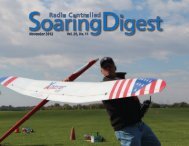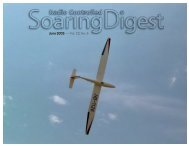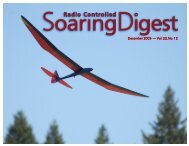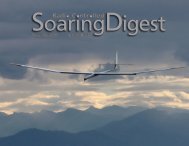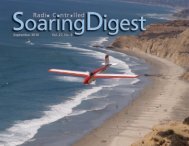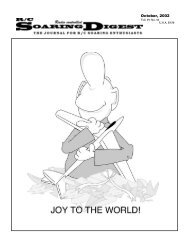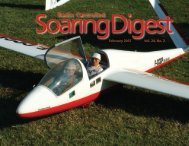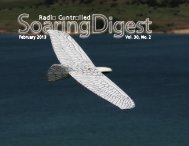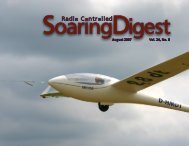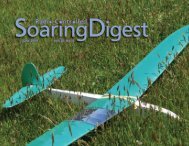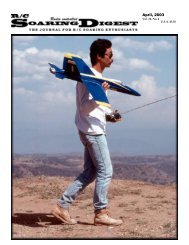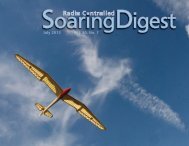August 2006 Vol. 23, No. 8 – R/C - RCSoaring.com
August 2006 Vol. 23, No. 8 – R/C - RCSoaring.com
August 2006 Vol. 23, No. 8 – R/C - RCSoaring.com
You also want an ePaper? Increase the reach of your titles
YUMPU automatically turns print PDFs into web optimized ePapers that Google loves.
In a thermal, always turn in the same<br />
direction. Changing directions will<br />
undoubtedly be detrimental as it means<br />
finding the thermal center again.<br />
Use rudder to make flat turns if the<br />
thermal is light, as the wing will not have<br />
to generate as much lift.<br />
“Use only the lift you need to make your<br />
time” (Joe Wurts), and tune your airplane<br />
to the weather conditions of the day by<br />
adding ballast.<br />
Receiver performance is extremely<br />
important in a contest environment. There<br />
may be 15 or more transmitters operating<br />
at the same time, you’ll be flying close to<br />
other aircraft and transmitters, often with<br />
multiple signals between you and your<br />
plane.<br />
At the start of a contest, the CD should<br />
outline the field boundaries and any no-fly<br />
zones. Tasks are usually predefined for<br />
each round, with heats (a portion of the<br />
entered pilots fly together), and rounds (all<br />
pilots having flown one round before<br />
starting another).<br />
Adam had a portable PA system and a<br />
specially made CD all set up, just as he<br />
does at the local contests he CDs. He broke<br />
clinic participants into two groups and had<br />
the first group fly a heat with the second<br />
group timing for them. The task was 10<br />
one minute flights (60 seconds maximum)<br />
in 10 minutes. This equates to the top ten<br />
flights under one minute, as anything over<br />
one minute doesn’t count. This means you<br />
Adam and Phil showed how to predict where a thermal will be. Here Adam nonchalantly<br />
catches his Encore after flying a good distance downwind to soar in a predicted thermal.<br />
want to fly 57 to 58 seconds for each flight,<br />
so you can catch your plane, and turn and<br />
launch quickly for maximum flight time.<br />
After the heat was over, the groups<br />
switched roles. This sample round was<br />
quite an education for everyone. The major<br />
point learned was that being a timer for<br />
someone else can be a better teacher than<br />
flying yourself.<br />
Russ McMillan is already talking about<br />
having a similar PSSF RC-HLG Clinic next<br />
year, with adequate lead time to post it on<br />
the various regional events calendars. If<br />
you live in the Pacific <strong>No</strong>rthwest, check<br />
out your local club message boards for<br />
announcements.<br />
P.S.: The barbecue was excellent!<br />
<strong>August</strong> <strong>2006</strong> 53



